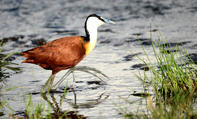
Name
African jacana (Actophilornis africanus)African Jacana Appearance
The African jacana is around 30 cm in length, with the female being up to double the size of the male. The plumage is chestnut in colour, with black wingtips and a patch of orange on the chest. The back of the neck and an eye strip are black. The bill and frontal shield is pale blue in colour, with dark brown eyes.This bird has very long slender legs, toes and claws for its size.
African Jacana Diet
The jacana's diet is primarily insects, but it is supplemented with crustaceans, snails, crabs, and small fish.African Jacana Breeding
The African jacana is polyandrous. Polyandry means that a single female will mate with many males, and the males in the African jacana case are also responsible for the parental care of the eggs and chicks.
The female will mate with a male and as soon as she has laid the eggs, she will move on to a new male, leaving the male to incubate and raise the chicks. The female lays around 4 eggs in a nest on a floating platform. The male will incubate the eggs for around 25 days, with the chicks fledging around 50 days later.
During the first couple of weeks after the chick’s hatch, the male has a specially adapted wing and is able to carry the chicks under the wing to keep them warm and dry. The same adaptation is used for the eggs if the nest gets wet.
African Jacana Behaviour
The African jacana is also known as a “lily walker” as they are able to walk across the water using the water lily as support. This is due to the very long toes and claws that spreads the weight of the bird across the lily. The African jacana is highly nomadic, due to water level fluctuations.
African jacanas are sociable birds and will gather in large groups outside of the mating season. During mating season, the female jacana will defend a large territory, that encompasses multiple male nesting territories.
The female African jacana is one of the few birds that practise infanticide. When a female takes over a new territory, she typically kills all the chicks found in her new territory, to ensure all the chicks are hers.
African Jacana Threats
NoneAfrican Jacana Distribution and Habitat
In South Africa, the African jacana is abundant in the eastern regions and less abundant in the other regions.African jacana habitat is freshwater and they are found along the margins of slow-flowing rivers or lakes, with some vegetation cover. They favour water that is covered with water lilies.